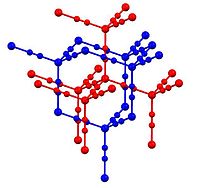
Photo from wikipedia
Abstract Spinodal decomposition of partially miscible polymer blends has the potential to generate well-defined polymeric nanostructured materials, with precise control of length scale and connectivity, and applications ranging from membranes… Click to show full abstract
Abstract Spinodal decomposition of partially miscible polymer blends has the potential to generate well-defined polymeric nanostructured materials, with precise control of length scale and connectivity, and applications ranging from membranes and scaffolds to photovoltaics. In this review, we briefly summarize the theoretical basis for describing spinodal decomposition in binary polymer blends, and the parameters that determine the accessible demixing length scales and the timescales over which they develop. We then examine experimentally the validity of the classical Cahn-Hilliard (CH) theory prediction for the initial spinodal length scale, Λ ≡ 2 π / − G ″ / ( 4 k ) where G′′ is the second derivative of the free energy of mixing with respect to composition, and k is the ‘square gradient’ parameter, accounting for changes in free energy arising from concentration gradients. Benefitting from the perspective of over 40 years of neutron and light scattering data, and noting (remaining) misconceptions in the literature when analyzing phase separation, we examine a large collection of Λ measurements, and independent -G′′(T) and k experimental estimates. Overall, we find the CH prediction for Λ to be remarkably accurate for all blends and self-consistent conditions examined. We then summarize design considerations for generating polymeric materials via spinodal decomposition, bound by thermodynamics of available polymer systems, coarsening kinetics governed by rheology, as well as by engineering constraints. The fulfillment of the potential of this approach in the development of real functional materials demands, however, improved thermodynamic theories for polymer blends, able to quantitatively predict G′′(T) and k in terms of molecular structure and interactions.
Journal Title: Progress in Polymer Science
Year Published: 2018
Link to full text (if available)
Share on Social Media: Sign Up to like & get
recommendations!